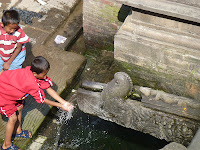We had a long layover at Incheon Airport so we tried something new. We contacted a local guide through toursbylocals.com and booked a walking tour. The logistics worked very well since it was easy to catch an airport bus into Seoul (took a little over an hour) and meet BongWoo Nam at the Anguk subway station. We saw a lot of interesting things in a short day, and managed the language barrier fairly well (we had expected the guide to speak better English than he did). But, hey, he spoke much better English than we spoke Korean!


The first thing we did was visit a section of the city that has sought to preserve a community of Hanok (traditional Korean) houses. It's a residential and business community; the city has made efforts to preserve the hanok and revive this part of Korea's cultural legacies. Artisans have moved here also, maintaining and revitalizing traditional crafts.
We were intrigued by Seoul - a very large (10 m), extremely clean and visitor-friendly city. We loved the public art and the re-creation of a stream that had historically flowed through the city but had been covered up by highways.
The area around city hall was celebrating the fact that 67 allies had supported South Korean during the Korean War. All of their flags were represented, along with a placque that indicated that number of allies in a war was a world record.
 |
| Changing of the guard at Deoksu Palace |
We also visited Deoksu Palace, one of the five main palace compounds established by the Joseon dynasties (1392 - 1910).

 |
| Eating a biscuit |
We would definitely return for longer and are confident that we could make our way around without a guide.

 We stopped in Kauai for a week - with the purpose of rest and relaxation. Sort of like the monk seal on the right, except with books.
We stopped in Kauai for a week - with the purpose of rest and relaxation. Sort of like the monk seal on the right, except with books.



















































